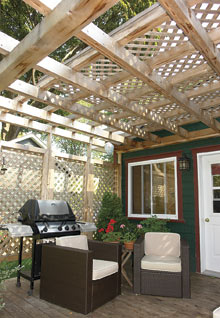 |
Energy efficiency has dominated residential construction trends over the past year. An entirely different efficiency, however, is currently shaping the deck and patio construction industries. Consumers want a custom built feel with an emphasis on economy of space and the use of quality materials.
Demand has shifted from the large, amenity-laden, treated pine deck of the past to a smaller and higher quality product. Durability and an efficient use of space are being put at a premium. STEPHANE BEAULIEU, president of Patios et Clôtures Beaulieu in montreal has remarked the trend in his own business and sees the opportunity it has created for contractors willing to adjust to meet the needs of their customers.
"You don't have to sell a big deck to make money," says Beaulieu. "Sell the right deck, customize it, and people will appreciate it more. People will pay a little bit more for that difference because it's custom, and more what they want instead of something that is imposed or out of a catalogue."
The industry-wide shift toward cedar is a prime example of customers' willingness to pay for quality. Companies like Prairie Cedar Homes point to cedar's longevity as well as its tendency to warp and crack less than other woods as reasons for its growing popularity in Colhurst, Alberta.
"Cedar is a stable wood and it's very user friendly to work with," points out JAKE VAN SCHOTORST, manager of Prairie Cedar Homes. "Typically it's less willful than a spruce or a treated spruce would be; more prone to be straight or flat."
Cedar offers a number of other advantages over pine, including a superior R-value, as well as a greater resistance to mould, mildew, fungus and insect infestation. In fact, the advantages are so significant that Beaulieu has begun quoting the cedar price to his clients even if they requested the project in another wood.
 |
"I give them the price for cedar as well, so they can compare and evaluate," Beaulieu says. "And more and more we're building 100 per cent cedar decks - 100 per cent meaning surface. Because of the costs of those two-by-eights, we don't do the structure out of cedar."
The change in materials is especially pronounced where handrails are concerned. To get away from the splintering that often results from pressure treated woods being used as railings, contractors are employing more aluminum hand rails and, to a lesser extent, cedar again.
"I don't put pressure treated railings on my decks anymore," Beaulieu says. "Even if a client signs for a pressure treated deck, there's no pressure treated railing; it's a cedar railing. It will look nice for the first two or three months, but the spindles will crack, it will warp, the posts will crack. You'll have a big crack in the middle of the post and because you are sitting two or three feet from that post on your deck you'll see it every day. It will bug you, you will call me and I'll have to come exchange it and I don't want to do that."
Working in Tight Spaces
Gone are the days of one-size-fits-all home projects. New lots are getting smaller and smaller and that's the driving force behind many of the trends in deck construction today. It also creates a number of logistical headaches for builders.
"We've demolished decks that were five to seven years old because they were too big for the backyard," says Beaulieu. "A contractor sold them a big deck when they didn't need one and there was no more land to use."
In an effort to maximize the dwindling size of the average backyard, builders are incorporating more 45-degree angles into their designs. As for the difficulties of getting materials on site, companies are resorting to taking materials through the house or lowering them from the roof where necessary.
As lots continue to shrink over time, the need for contractors to be creative and efficient in their design and execution will only grow. Customers will have less room to play with in their projects and that should only strengthen demand for high quality materials and custom designs.


